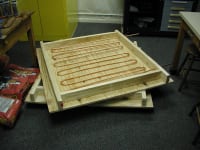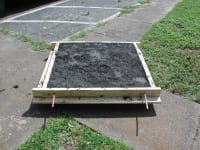We are experimenting with inserting a working fluid circulation loop into the asphalt pavement of shopping center parking lots to determine if the solar energy captured by the pavement can contribute substantially to the energy demand of stores, apartment buildings, schools and other high energy use properties. Asphalt pavement captures heat at the rate of 3.6 kilowatt-hours per square meter during the summer months in the Southwestern United States. Peak temperatures can exceed 75C, which is adequate to power ORC (organic Rankine Cycle) equipment to generate electrical power for lighting, refrigeration and air-conditioning. Our task is to develop methods and materials to economically harvest the thermal energy from the pavement. To that end, we are testing asphaltic concrete mixes, dye additives, stainless steel tubing for the circulation loop. We are constructing a turbine with low impulse impeller that we will drive with an organic refrigerant working fluid. An added benefit is that the heat flow can be reversed in winter to de-ice pavements and sidewalks.
Like this entry?
-
About the Entrant
- Name:Lee Fellows
- Type of entry:teamTeam members:Steve Alexander, PhD, Professor of Physics
Lee Fellows, Bsc, Science Facilities Coordinator
Shea Henry, Physics Student
Emma Harting, Physics Student - Patent status:none





